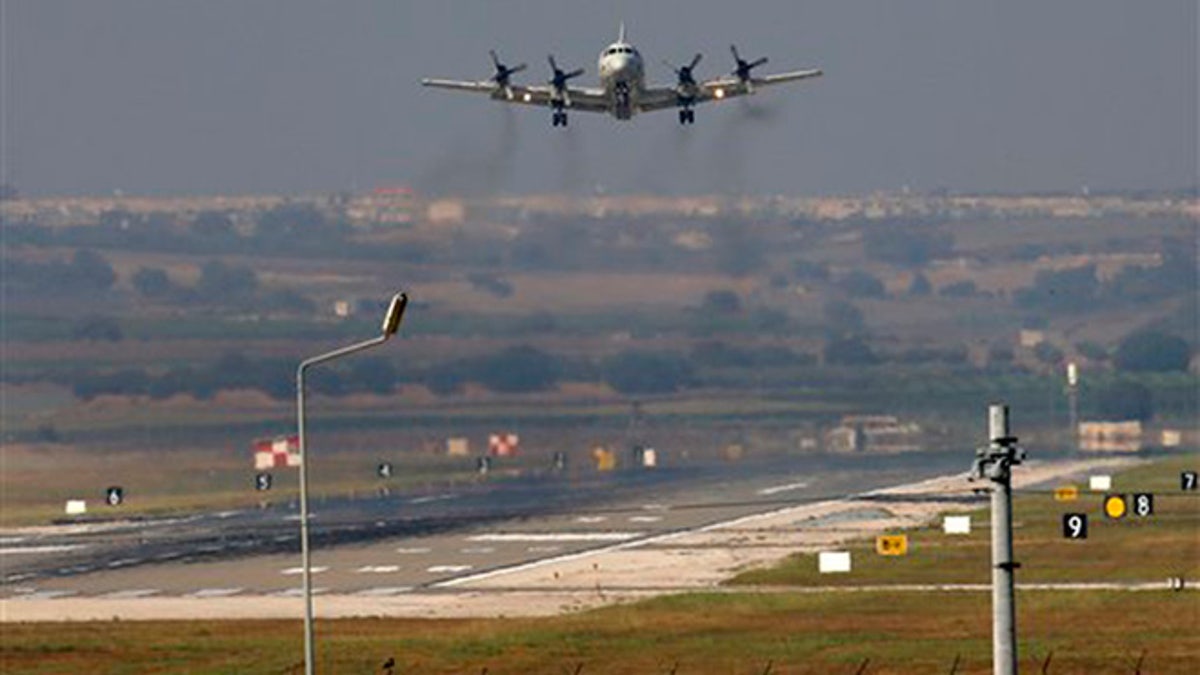
A United States Navy plane approaches to land at the Incirlik Air Base, in Adana, in the outskirts of the city of Adana, southeastern Turkey, Tuesday, July 28, 2015. (Incirklik airbase in Turkey where Turkish and American forces operate)
The U.S. has declined to confirm that a Syria “safe zone” was to be created in the northern part of that country despite reports that it was part of a recent agreement between the American and Turkish governments in the fight against ISIS.
Several senior administration officials, speaking to reporters on a background call Tuesday afternoon, said the U.S. is not calling for a “safe zone” or a “no fly zone” to be created in northern Syria, despite the insistence of the Turkish government that this was the case.
“We are not out there staking out zones," said one senior administration official. "That is just not what is happening, we are going after ISIL wherever we can find them…once we get our aircraft planning done, you are going to see a lot of results."
The officials said planning remains in the early stages, and they would not disclose specific details because they are still being worked out.
“We’re just now sitting down with Turkish counterparts to begin to plan,” said one senior administration official when asked for a basic outline of the deal between the U.S. and Turkey over sharing its bases with the U.S. to fly armed and in some cases manned strike missions against ISIS.
Previous missions from Incirlik Air Base and other bases in Turkey where the U.S. military has a presence have, until now, only consisted of reconnaissance flights over Syria from unarmed drones.
That will begin to change, according to a defense official, not on the call, with knowledge of the basic agreement with Turkey. He said the agreement up to this point is only one to “heighten efforts.”
Strike missions against ISIS from bases such as Incirlik in the near term will most likely be armed drones because the administration does not want manned warplanes from the U.S. flying near the Assad regime’s forces outside Aleppo or other areas near Turkey’s border with Syria, where ISIS remains in control.
The “last stretch” of border containing elements of ISIS that has yet to be cleared by Syrian Kurdish fighters is 68 miles long, according to one senior defense official. It extends between the towns of Azaz to Jarablus in northern Syria, west of Kobani and north of Aleppo.
“It will not be a no-fly zone, just as Kobanai was not a no-fly zone,” said one official. “The objective is to get Daesh out of this area and allow life to return.” Daesh is another word for the so-called Islamic State, or ISIS.
When asked if the U.S. government gave permission for Turkey to strike the Kurdistan Workers’ Party, better known as the PKK, a Marxist-Leninist inspired group the U.S. considers a terrorist organization, a senior administration official said the agreement was reached before the PKK attacks inside Turkey.
For 30 years the PKK has waged attacks against the Turkish government, killing 40,000 people.
The basic agreement reached between Turkey and the U.S. came together roughly two weeks ago, “shortly before” President Obama and Turkish President Erdoğan spoke, according to one senior administration official. Recently, the PKK launched a series of attacks inside Turkey, killing Turkish police officers and soldiers.
“PKK then took credit for those attacks and promised more attacks. That was the triggering event for the Turkish airstrikes in northern Iraq,” said a senior administration official. “Turkey has a right to self-defense and we fully support them."
